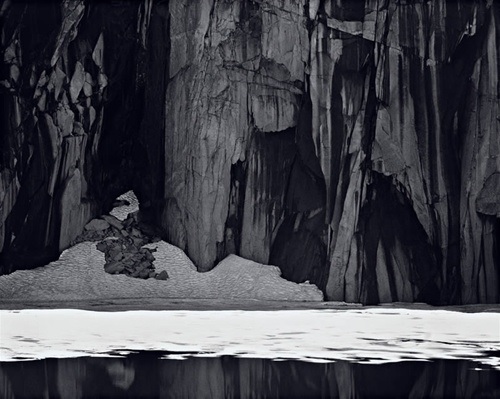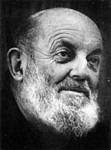See also Winter Sunrise, the Sierra Nevada from Lone Pine, California (R)

Ansel Adams
American, 1902-1984
Frozen Lake and Cliffs, The Sierra Nevada, Sequoia Nat'l Park, CA, 1932, printed 1979
gelatin silver print
17 1/2 × 21 1/2 in.
SBMA, Gift of Margaret W. Weston
2010.55.1

Undated photo of Adams
"I believe I was able to express in this photograph the monumental qualities of the subject that I responded to so intensely at first sight." - Ansel Adams
COMMENTS
A. What do you observe?
This image is a striking organization of contrasting shapes, textures and values. The smooth reflecting water contrasts with the craggy cliff; the white floating ice and the black lake form a calm horizontal against the tense vertical of the abruptly rising gray rocks. The irregularly shaped mound of snow acts as a visual buffer. Adams used these elements of art - shape, texture, and value - to create a composition that, although of a recognizable subject, could be termed abstract.
B. Does the scene strike you the same as it did Ansel Adams?
Are the looming cliffs, extreme cold and isolation threatening? Or are other feelings aroused, such as wonder and curiosity? Does the photograph stir any association or memories? Adams said in Examples, "…I believe I was able to express in this photograph the monumental qualities of the subject that I responded to so intensely at first sight." He asked himself the question, "why do I see certain events in the world about me that others do not see?" There were several good photographers nearby, and "the scene was before us all, but no one else responded with creative interest…With all art expression, when something is seen, it is a vivid experience, sudden, compelling and inevitable." The visualization is "called forth by some miracle of the mind-computer," not consciously, but is "a summation of total experience and instinct".
C. How did Adams arrive at taking this photograph?
On a hiking outing with the Sierra Club, in the most spectacular region of the Sierra, he came across this scene at what was later given the descriptive name of Precipice Lake, which lies at the base of Eagle Scout Peak. "The lake was partially frozen and snow banks rested in the recesses of the cliffs. I was impressed with the solemn beauty of the scene and saw the image quite clearly in my mind."
D. How did the philosophy of Group f/64 affect his vision?
Adams joined with Edward Weston and other like-minded photographers who were disgusted with pictorialism, which they thought was soft-focused, romantic and sentimental and imitative of other media such as painting and drawing. They promoted straight" or "pure" photography, which they defined in their manifesto as photography that did not derive from any other art form, but must "develop along lines defined by the actualities and limitations of the photographic medium…"
James Alinder, in Ansel Adams - Classic Images, wrote that for Adams, Group/64 provided a unity of thought and style, and "proposed methods that would produce images with the most distinctively photographic characteristics." They used large 8X 10" negatives, lenses that gave extreme optical sharpness, and contact prints with a full tonal range. Adams' work underwent change. Adams took the group's convention of doing close-up views, and transferred it to landscape, his preferred subject, in Frozen Lake and Cliffs. Alinder observes, "Without a defining horizon, the frame filled with fragmented granite shapes takes on a new sense of abstraction."
Did Adams himself see this photograph as "abstract?' He says in Examples, "I was not conscious of any such definition at the time. I prefer the term extract over abstract, since I cannot change the optical realities but only manage them…For photographic compositions I think in terms of creating configurations out of chaos, rather than following any conventional rules of composition."
E. What problems did he face in the years before he developed the Zone System?
Adams describes in Examples how "the deeply shadowed recesses of the cliffs contrasted with the blinding sunlit snow" and taxed his "intuition and the range of the film as well." The ice of the lake was glaring. He had not yet developed his Zone system, and couldn't precisely measure the luminance. He made an educated guess and "hoped for the best." He said he was "fortunate" in his results in these years of his "technical insufficiencies." After he developed the "Zone System, the guesswork was removed from unfamiliar situations, and good control of results became possible."
F. Technical Aspects
Frozen Lake and Cliffs was taken early in his career when Adams said he "did not yet have the necessary craft to relate exposure and development precisely for optimum results." He had not yet developed the well-known Zone system. The negative is degraded from being developed in exhausted developer, which makes it "very difficult to print." It requires considerable craft in burning in areas to balance the tones. "Making the print involves the use of many controls and trials to obtain results that approximate what I saw and felt when I made the exposure."
Camera: 4 X 5 Korona View camera
Lens: 10-inch Goerz Double Anastigmat lens, with a component with a focal length of 19 inches, which gave him precisely the composition he visualized. A normal focal length of 6 1/4 inches would have included a much larger field of view.
Paper: Oriental Seagull Grade 4
- Housatonic Museum of Art, Bridgeport, CT
http://www2.housatonic.edu/artmuseum/anseladams/details/frozenlake.html
SBMA CURATORIAL LABELS
One of the most influential photographers of the 20th century, Ansel Adams is certainly not an unknown talent. Nevertheless, his surname has come to be associated with a very specific kind of landscape view—the craggy mountain peak, the deep perspective provided by a convenient vista, the silver-lined wisps of cloud overhead. Assembled here is a group of photographs that shows the range of Adams’s art. Together these works posit a challenge to the conventional view of Adams—whether by his use of flattened perspective, a foray into a lesser known genre (such as portraiture), or lavishing attention on a singular object rather than a vast panorama.
Adams’s fate was seemingly foretold when at 14 years old, he received a Kodak Brownie as a gift while on a family vacation to Yosemite National Park. His career is marked by a series of distinguishing moments: in addition to inventing the “Zone System,” a technique for perfecting the exposure and contrast of prints still taught today, he also played an integral role in creating the photography department at the Museum of Modern Art, New York, and alongside Edward Weston, founded Group f/64, which championed straight, unmanipulated photography over the painterly qualities of Pictorialism.
The 1930s were a time of photographic experimentation for Adams, and they also brought on a new ecological awareness—the result of contract work with the U.S. Department of the Interior. His photographs of state parks have since become instrumental in advocating for wilderness preservation. Adams went on to a series of landmark achievements, from forming the photography department at the San Francisco Art Institute to founding "Aperture" magazine, and receiving a major retrospective at the Museum of Modern Art. The same photographs that galleries were reluctant to display as “art” during a large part of Adams’s life are now hailed as masterpieces of the American landscape.
- Crosscurrents, 2018
